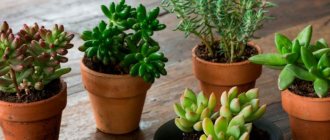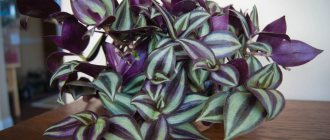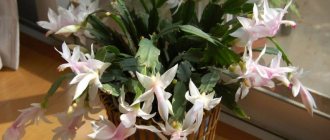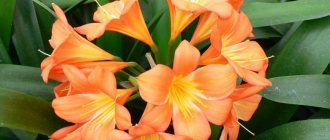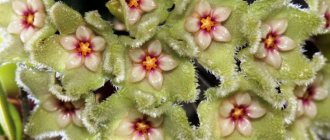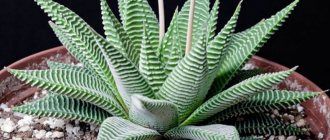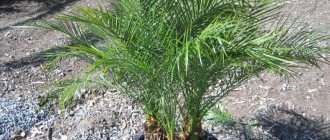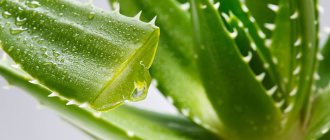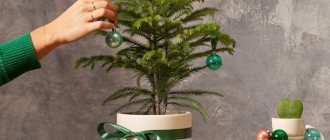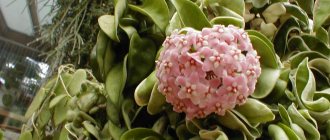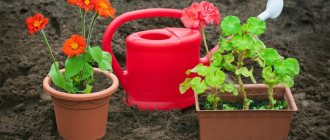Morgan's sedum is an attractive, unpretentious plant that even novice gardeners can grow.
This succulent is well adapted to the climate of city apartments, tolerates periods of drought well and is suitable for those people who, due to their occupation, are forced to often leave home. However, a flower becomes most decorative when all the rules for its maintenance are followed.
Choose the right type
Sedum (Sedum spp) will provide attractive texture with waxy foliage and graceful, vibrant flowers. Properly selected plants in combination with the container in which they will grow will complement the design of the room, be it a living room, kitchen or bathroom.
Many varieties of these indoor plants can be considered unpretentious in care. Growing at home does not require much effort, but you need to choose a variety suitable for cultivation in the chosen room and provide favorable conditions.
Bright and heat-loving varieties are the best choice for indoor growing. The plant will receive a sufficient amount of sunlight if it is placed next to a window. Six hours of light every day is the minimum required for normal growth. Normal growth is easy to notice: 2-2.5 cm of increase in length per month indicates favorable conditions.
Flower buds start out similar to broccoli heads, forming early but taking longer to develop than those of normal plants. The description of the flower is surprising in its diversity; the inflorescences have different shades, starting with pale tones, then becoming more saturated as they mature.
The flower heads are attractive from the buds until they dry out, and rarely produce seeds under indoor conditions.
Types and varieties of sedum: photos, names and descriptions of popular plant varieties
It is impossible to say exactly where the name of the plant came from. There are two main versions.
According to one version, the name of the plant comes from the word Sedo, which translates as “to subside”, “to calm down”, “to relieve pain”. The fact is that in ancient times, the above-ground parts of the plant were actively used to relieve pain.
Adherents of the second version believe that the name comes from the word Sedeo, which means “to sit.”
As you can see in the next photo, the sedum plant, or sedum, seems to be “sitting” on a stone:
Also, if you look closely, it is noticeable that the leaves do not have petioles, but extend directly from the trunks.
The plant is mainly intended for growing in gardens; with its help you can create a rather interesting design for your garden plot.
At the same time, a number of types of sedums, or sedums, are used as indoor plants.
Look at the photo, which shows several varieties and types of indoor sedum with the most minimal care requirements. Among them:
Sedum thickifolia
Sedum Makino
Sedum lineara "Variegata"
Sedum Siebold
Sedum Weinberg
Some species are poisonous. These include the large sedum (Sedum maximum). It is quite common in Europe and likes to grow on river shallows and pine forests. Despite the beauty of the leaves, which grow thickly and have a rich green color, gardeners avoid growing it in apartments, because the juice of the plant is extremely poisonous.
Indoor sedum includes several types, including:
Sedum Morgana
Sedum red-colored
Sedum Steel
It is worth understanding that heat-loving species are grown indoors. Some of them need to be considered in more detail.
Siebold's sedum (Sedum sieboldii) with thick pink-green leaves is a hanging perennial plant. It is believed that the birthplace of this species is Japan.
Under natural conditions it grows on the island of Shikoku. But you can grow such sedum at home. This type of sedum is planted in hanging flowerpots, pots, and baskets. It is often used as a greenhouse plant.
The stems of the plant are thin, have a reddish tint, and reach a length of 5-10 cm. The plant does not have the ability to take root in nodes.
As for the leaves, they are gray-blue or bluish-green, with a reddish tint along the edges, and have blunt jagged edges. Each leaf can reach up to 3 cm. The smallest leaves are approximately 1 cm in size.
Take a look at the photo showing a type of sedum called Sedum sieboldii:
A peculiarity of its cultivation is that its faded stems cannot be removed until spring. In the spring, the sedum is replanted and the dried parts are removed. A mixture of compost soil and coarse sand is used as soil.
The following varieties of this type are popular:
Mediovariegatum - with grayish leaves, in the center of each of which there is a beige spot that turns red during the growing season.
Aurora - has leaves colored purple.
If you carefully examine the indoor cultivated sedum plant, the leaves seem to sit on the shoots, thereby forming whorls.
Flowering time August – end of September. If weather conditions are favorable, flowering may continue until mid-October. The flowers are located at the ends of the shoots and are collected in corymbs. The flower petals are pink, with a lilac tint, in the middle the color turns closer to cherry.
If the plant is grown in a temperate climate, then fruits are not formed. During the winter period, leaves fall and new ones appear with the arrival of warmth.
If you are caring for this type of sedum at home, you should carefully study its needs. It is important to remember that there is the following rule: Sedum sieboldii must overwinter at a temperature of at least 5 ° C in order to form new shoots the next year. In addition, too intensive feeding causes the colors to fade.
Morgan's sedum (Sedum torganianum) , like Siebold's sedum, also droops, its leaves with gray frost are located like scales on shoots up to 1 m long. The homeland of this species: Mexico.
The leaves are oblong-elliptical, round in shape, on average 1.5 - 2 cm in length. They are quite fleshy, generally 5mm wide. You need to know that the leaves fall off at the slightest touch.
The flowers of this sedum (sedum) are arranged in the form of an umbrella of 10-15 pieces. The plant blooms profusely, the flowers are pink-red, approximately 1 cm in length. This type can often be seen in apartment windows.
The following photos show types of sedum in indoor conditions with quite a large number of flowers:
The most popular variety of this species is Sedum Burrito, which is distinguished by the shape of its leaves: they are more rounded and without a bluish tint.
It blooms in late spring - early summer with soft pink bells.
Blushing sedum is a compact plant whose shoots spread along the ground. Over time they rise a little. The leaves are round and spindle-shaped, they are crowded in apical rosettes.
The leaves of Sedum rubrodnctum are dark green but turn reddish in a warm, dry room. The flowers have a beautiful bright yellow color.
Sedum Steel is native to Mexico. This sedum responds well to home care, despite the fact that in nature it is found high in the mountains, at an altitude of up to two and a half meters above sea level.
This type of sedum is a perennial subshrub, reaching a height of up to 20 cm. The leaves are ovoid, up to 12 mm long and up to 8 mm wide. The color is brownish-red with light down, in the same tones.
It is better to place the flowerpot on the sunny side, as this is a heat- and light-loving plant. You should not apply mineral fertilizers to the soil, otherwise the leaves may lose their decorative properties.
Care must be taken not to overwater the plant; it is drought-resistant and it is better to underwater than to allow moisture to stagnate.
Take a look at the photo of this variety of sedum, where you can see the features of this flowering plant:
Its inflorescences are apical, paniculate, with yellow flowers. With proper care, it will bloom in August-September. Sedum Steel easily sheds leaves, from which new shoots can appear without human intervention.
Some types of sedum, particularly caustic ( Sedum acre ), can be found in the wild. This unpretentious species grows in infertile, dry soils and forms continuous carpets up to approximately 7 cm in height. They are generally green, but are covered in yellow flowers when they bloom.
In this form, there is a variety called Yellow Queen , which is a spectacular perennial plant with small, fleshy, light green-lemon leaves.
Look at the photo of a sedum variety called Yellow Queen and its flowers that look like stars:
The inflorescences consist of shortened branches with almost sessile flowers of a poisonous yellow color. Dense flowering occurs in mid-summer. The fruits are formed in August - early September, this is a box with seeds inside.
It is quite difficult to find the differences between sedum and hexagonal sedum.
Look at these types of sedums with names in the photo:
Both caustic and hexagonal sedum have yellow leaves and stems, but in the second type the leaves are arranged on the stem in such a way that it actually appears hexagonal.
In addition to the well-known variety Yellow Queen, the following varieties are also popular in this type of sedum:
Elegance - with twisted, grayish leaves, shaped like sea coral.
Aureum - the tips of the shoots are colored yellow.
Blue Forest - with blue-green rounded leaves and bright flowers.
A notable feature of the listed varieties is their fleshy stems and leaves. These are drought- and winter-hardy plants that bloom from mid-spring to late summer.
Also suitable for growing on poor soils is white sedum (Sedum album) , which is quite aggressive to fertile soil and rapidly grows into a low carpet.
The bases of the stems spread along the ground, which is why this species is used as a ground cover plant. It blooms in May with numerous, small, fragrant flowers. All varieties tolerate cold winters and the harsh climate of central Russia.
The following varieties of white sedum are popular:
Coral Carpet - low bushes reach 5 cm in height, the leaves acquire a purple tint in autumn.
Atum - have flat foliage that turns red in the sun in summer.
Faro Form - has very small leaves, forms a low carpet (up to 1 cm). It turns red in summer and turns brown in autumn.
Hillebrandti is a variety with large leaves that turn orange-red in summer.
Murale - stems and leaves are completely reddish-brown.
Pay attention to the photo depicting the white sedum species and its varieties Coral Carpet and Murale:
The leaves of these plants have different shades of red and brown. They change under the influence of sunlight and depending on the time of year.
On the street and in the room
Versatile varieties grow outdoors and indoors. Beautiful tender Sedum plants that grow well indoors in winter and can be displayed outdoors in summer:
- compressed sedum (Sedum compressum), will bloom all winter,
- tree sedum (Sedum Dendroideum ssp. Praealtum), a small tree with strong green leaves,
- Morgana Cristata (Sedum Morganianum Cristata) with shoots divided at the ends,
- Sedum Nussbaumerianum creeping shoots with orange leaves.
In winter, care at home will not be burdensome, and as the weather warms up, these plants can be moved to the balcony or open street space.
Reproduction of sedum in the garden and at home
Sedum spurium is propagated in the same way, regardless of where the plant grows: in an apartment or in a garden. There are three popular and frequently used ways in which sedum can propagate: by seeds, by dividing the bush and by cuttings.
Sedum is propagated by seeds in early spring. First, the planting material is soaked in a disinfecting solution and then dried. Seeds are planted in a box with a nutrient substrate at a distance of 2-4 cm. After this, the soil is moistened with a spray bottle and the container is covered with cellophane.
Note! For vegetative propagation, cuttings are taken from an adult bush. You can cut a leaf with bud nodes or a part of the stem. It is recommended to bury them 1-2 centimeters into the substrate. Water lightly, or simply moisten the soil with a spray bottle.
It is best to divide the bush when transplanting it into a new container. To make the task easier, it is first watered for a couple of days, after which it is pulled out of the pot and the old soil is partially removed. It is better to divide an adult bush into 2-3 equal parts, each of which is then planted in separate containers.
How to replant
Transplantation of seedlings and adult plants can be done at any time, but gardeners usually do this in the spring. Prepare a nutritious soil mixture in advance. Purchase a ready-made mixture specifically for succulents or make it yourself. To do this, take loose soil and mix it with sand and any organic fertilizer.
Result of insect pestilence
Reproduction
Plants are propagated in two main ways:
- cuttings (vegetatively),
- seeds.
Vegetative propagation is the most common and gives quick results. Since the attachment to the leaf of these plants is rather unreliable and fragile, when manipulating the leaves the stem itself easily breaks off. In this case, you can do nothing with the fragment, just leave it in the air.
The plant's reserves will last for a long time, the leaves will remain alive for a long time until small roots appear. Then you can place the cutting in a flower pot without burying it deeply. With moderate humidity, the plant will continue to grow.
Propagation by seeds is the “aerobatics” of plant growers; it will require effort, but it will pay off with the rare species grown. Seeds are usually purchased from specialized online resources, where they will also tell you about cultivation.
General growing rules should be strictly followed:
- Before planting, mix the seeds with sand or talcum powder to ensure even distribution.
- Sow seeds directly onto prepared soil.
- You cannot cover the seeds with soil; they just need to be lightly pressed into the soil.
- Water either from below, from a tray, or spray a fine mist. Watering with water will simply wash away the seeds and the uniformity of seedlings will be disrupted.
- The seeds should not be allowed to dry out; during germination they should be kept moist, but not wet, and water should not completely cover them.
Necessary conditions for cultivation
Sedum Morgana is best grown in hanging planters or pots placed on a tall flower stand. When placing, it should be taken into account that this variety is fragile - at the slightest touch, the leaves break off and fall off.
Therefore, you should handle sedum and carry out any manipulations with extreme caution, and to maintain its decorative effect, create optimal conditions .
Rule 1: Location and Lighting
A large amount of direct sunlight and long daylight hours are the key to decorativeness and possible flowering of sedum. It is best to place the sedum on a south window or in close proximity to it, in rooms with a southeast or southwest orientation.
Windows facing north are not suitable for light-loving plants. A lack of natural light will cause the sedum stems to stretch out unevenly and the distance between the leaves to lengthen.
Advice! If the apartment windows face the north side of the house, and the desire to grow Morgana sedum is great, the lack of sunlight can be compensated for by artificial lighting from fluorescent or LED lamps. In this case, the duration of daylight should be at least 10-12 hours.
Rule 2: temperature and humidity
Morgan's sedum is “indifferent” to high air humidity; on the contrary, it is contraindicated for it. The flower does not need to be specially sprayed or bathed in the shower .
It is allowed to occasionally wash off dust from the plant using a gentle stream of a fine spray, but provided that the air temperature in the room is not lower than +16...+18°C.
The temperature of the succulent content depends on the time of year :
- from March to October +18…+28°С;
- from November to February +13…+16°С.
Lowering the temperature during the cold season is necessary to create a dormant period. At this time, it is also necessary to reduce watering and fertilizing . But it is necessary to ventilate the room where sedum grows daily. The flower needs an influx of fresh air both in summer and winter.
Rule 3: soil requirements and replanting
For growing Morgana sedum , any store-bought soil intended for planting cacti and succulents is suitable.
Basic requirements for the substrate :
- neutral acidity;
- looseness;
- good air and moisture permeability.
You can make your own soil mixture for planting a flower from garden soil, coarse river sand and peat.
Shallow wide bowls or flowerpots should be used as containers . The superficial root system of the sedum tends to grow in the upper layer of the earth and does not go to a depth of more than 5-10 cm.
Before planting sedum, you need to lay a drainage layer at the bottom of the pot or bowl with a height of at least 2-3 cm and no more than 1/3 of the total height.
For drainage, you can use expanded clay or pieces of foam plastic, broken red brick, shards from clay pots, crushed rock, sea or river pebbles.
Important! Morgan's sedum does not need to be replanted unless absolutely necessary, since any mechanical impact causes its fragile foliage to crumble and its stems to break. The flower can be grown in one pot for several years in a row and replanted every 2-4 years when the container becomes too crowded.
Happy life
The right growing conditions will make the difference between a plant that can tolerate indoor spaces and one that thrives, thrives, and flowers regularly. Basic conditions for indoor care: light, pot, soil and watering.
Pot and soil
A clay pot with drainage holes around the base is the best container for growing sedum. When replanting an adult plant, you need to take a pot 3-5 cm larger than the previous pot.
Sedum does not need rich soil, but it does need excellent drainage. For planting, choose soil with a “rich” composition or prepare it yourself. The prepared soil should consist of 2 parts potting soil, 2 parts river sand, 2 parts peat and 1 part baking powder - perlite or crushed charcoal.
Important: Sedum does not require fertilization. Their composition is difficult to select for uniform growth of a houseplant; fertilizers can change the shape of the leaves or stem.
If you still need to add fertilizer, it is best to choose a fertilizer with a slow release into the soil.
Propagation of indoor sedum: how to plant cuttings and leaves
Gardeners often choose cuttings as the easiest and most reliable way to propagate sedum. The smallest pieces of shoots that accidentally fall onto the bed during pruning have a real chance of taking root. In nature, they are often carried by small rodents or birds, so the plant is easily transported to new areas.
When planting and caring for an indoor sedum succulent, no special work is required. Often it is enough to simply tear off or cut a shoot and stick it into moist soil, then it will take root on its own.
To obtain a larger amount of planting material, use the winter cutting method. This technique is practiced for prominent sedum, which is most often used for landscaping garden areas.
At the end of flowering, before the first frost, healthy flower shoots are cut off without any damage. Before planting sedum shoots in the ground, they are laid out on racks in a dry, warm room.
Over time, the leaves will fall off the shoots, and shoots with roots will appear instead. You need to wait until they grow to 4-5 cm in length, then break them off and plant them in the soil.
They take root at a temperature of 18-22°, but it’s not scary if the temperature is lower. It is necessary to ensure that the cuttings receive enough light and not overwater, otherwise the shoots will rot. At the end of spring, the shoots can be planted in open ground, and by autumn they will begin to flower.
To propagate sedum using apical cuttings, you simply need to cut off the top and place it in water or stick it into moist soil, and this unpretentious plant will germinate on its own.
If you use the last method - dividing the bush, then you should start in early spring. It doesn’t matter whether the sedum flowers are indoors or garden, it is necessary to dig up the rhizome in early spring, when the plant is just “waking up”.
The root removed from the ground must be divided into two parts so that both contain rhizomes and buds, from which shoots will subsequently grow.
You can divide the bush into four or five parts, the main rule: each part contains rhizomes and buds.
Another frequently used method is leaf propagation, which is well suited for indoor sedums - the method is the simplest and least labor-intensive.
What is required for this method:
- Pot or other container.
- Substrate intended for adult plants.
- Water at room temperature.
- Sedum leaves.
Pour soil intended for replanting an adult plant into the pot and moisten it. Next, simply spread the leaves over the surface. After 7-10 days, the leaves will take root and young shoots will begin to grow.
Watering
Proper watering is vital to maintaining the health of indoor sedums. The soil should be checked every day by testing the moisture content with your index finger at the depth of the roots. This is approximately 2-2.5 cm below surface level.
Water only if your finger is dry. Add water until the soil is saturated with moisture and excess liquid drains from the drainage holes.
How to water a flower in winter? At this time, water less frequently and allow the soil to dry completely. Sedum leaves will tell you when to water. If they begin to wrinkle slightly, it is time to water.
Pests and diseases
The plant genus Sedum is a broad group of perennial species that are collectively hardy and easy to grow. They only get sick from excess moisture; the roots of plants can rot in such conditions.
Powdery mildew, aphids and weevils can sometimes attack plants. The best solution is to simply wash off these pests with water. Wash carefully; stems and leaves break easily.
Hardy plants, even without flowering, are worth growing because of the leaves, which come in different shades, as shown in the photo of Sedum varieties. Taking into account the wide range of species, you can always choose a suitable flower arrangement to decorate a room or space.

